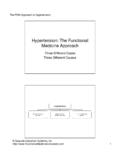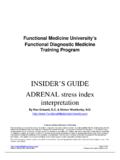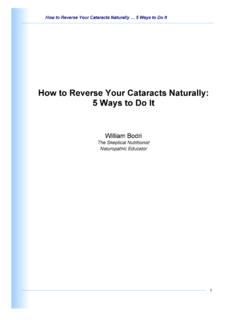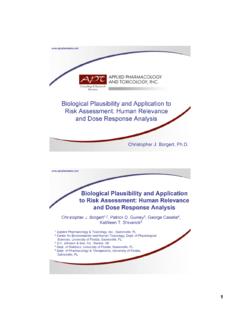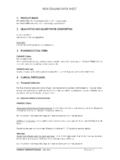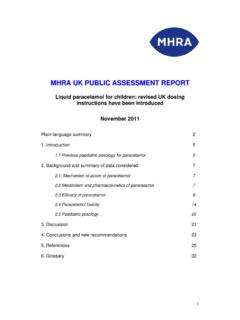Transcription of INSIDER’S GUIDE RBC MINERALS/TOXIC METALS …
1 Functional Medicine Training Program Page1 of 10 insider s GUIDE RBC Minerals and Toxic METALS Copyright 2008 Sequoia Education Systems, Inc Functional Medicine University s Functional Diagnostic Medicine Training Program insider S GUIDE RBC MINERALS/TOXIC METALS INTERPRETATION AND TREATMENT By Ron Grisanti, & Dicken Weatherby, Limits of Liability & Disclaimer of Warranty We have designed this book to provide information in regard to the subject matter covered. It is made available with the understanding that the authors are not liable for the misconception or misuse of information provided. The purpose of this book is to educate. It is not meant to be a comprehensive source for the topic covered, and is not intended as a substitute for medical diagnosis or treatment, or intended as a substitute for medical counseling. Information contained in this book should not be construed as a claim or representation that any treatment, process or interpretation mentioned constitutes a cure, palliative, or ameliorative.
2 The information covered is intended to supplement the practitioner s knowledge of their patient. It should be considered as adjunctive support to other diagnostic medical procedures. This material contains elements protected under International and Federal Copyright laws and treaties. Any unauthorized reprint or use of this material is prohibited Functional Medicine Training Program Page2 of 10 insider s GUIDE RBC Minerals and Toxic METALS Copyright 2008 Sequoia Education Systems, Inc RBC MINERALS/TOXIC METALS .. 2 INTERPRETATION AND TREATMENT .. 2 CALCIUM (CA) .. 3 CHROMIUM (CR) .. 4 COPPER (CU) .. 4 MAGNESIUM (MG) .. 5 MANGANESE (MN) .. 5 POTASSIUM (K) .. 5 SELENIUM (SE) .. 6 VANADIUM (V) .. 6 ZINC (ZN) .. 6 TOXIC METALS .. 6 ALUMINUM (AL) .. 7 ARSENIC (AS) .. 7 CADMIUM (CD) .. 7 LEAD (PB) .. 7 MERCURY (HG) .. 9 TIN .. 9 RBC MINERALS/TOXIC METALS Interpretation and treatment Functional Medicine Training Program Page3 of 10 insider s GUIDE RBC Minerals and Toxic METALS Copyright 2008 Sequoia Education Systems, Inc Red blood cell (RBC) analysis is an invaluable diagnostic method for measuring concentrations of elements in erythrocytes providing a look at how well cellular levels are maintained because erythrocyte mineral levels reflect mineral status over a period of 4 months (the life cycle of an erythrocyte).
3 Other specimens, like urine or plasma, are affected by daily dietary fluctuations. In the process of their formation in bone marrow, erythrocytes acquire nutrient elements like zinc according to the availability of each element. The same may be said for the toxic elements, which means that high levels of these raise suspicion of chronic tissue penetration due to toxic exposure and inadequate detoxification mechanisms. All of the essential trace elements are dependent on stomach acid production for intestinal absorption. Key Clinical Points on Erythrocyte Nutrients Calcium (Ca) Erythrocyte calcium levels are indicators of ionic calcium and are not related to dietary calcium. Functional Medicine Training Program Page4 of 10 insider s GUIDE RBC Minerals and Toxic METALS Copyright 2008 Sequoia Education Systems, Inc There are approximately 179 biological functions of calcium. Every cell is dependent on the presence of ionic calcium.
4 It is used in teeth and bones and the movement of muscles. It is required for the rhythmic action of the heart and the intestines. It is essential for the clotting of blood. It plays a role in infections, pregnancy, and in the maintenance of the acid-alkaline balance. Ionic Calcium is the only physiologically active form of Calcium. Because ionic calcium is the only physiologically usable form of calcium, calcium from all sources, whether from diet or from bones, organs, and tissues, must first be broken down into ionic form before it can be utilized by the body for any of the 179 plus biological functions. Erythrocyte calcium is associated with the etiology of heart disease and stroke playing a vital role in the induction of blood pressure elevation. Total erythrocyte calcium is elevated in hypertension and in postnatal hypoxic ischemic encephalopathy. Chromium (Cr) Chromium accumulates primarily in spleen and heart tissue. Numerous clinical studies have proven that chromium impacts sugar metabolism through its role in uptake of insulin, and losses of chromium in urine are related to increased mobilization in response to the stimulus of frequent blood sugar peaks.
5 Chromium also aids in lowering LDL cholesterol and raising HDL cholesterol. The best dietary sources include liver, brewer s yeast, nuts, and whole grains. Copper (Cu) Copper is a co-factor in lipid metabolism, liver detoxification and neurological control. This may be a giant statement but sometimes the cause and cure of high cholesterol can be as simple as correcting a copper deficiency by its involvement in lipid metabolism. Most copper is concentrated in liver, brain, and hair but is present in all other tissue. Best dietary sources are whole grains, nuts, seeds, beans, liver, and shellfish. Most of the copper present in erythrocytes is bound to the enzyme superoxide dismutase (SOD), which protects the cells from oxidative damage. Dietary deficiency of copper is seen as low levels of erythrocyte copper and SOD, even in early stages of copper depletion. Impairment of function due to copper deficiency may result from reduced activities of the enzymes, ceruloplasmin, monoamine oxidase, lysyl oxidase in connective tissue, and SOD.
6 Loss of these biochemical functions can lead to anemia, neural degeneration, lung and bone problems, CVD, and accelerated aging. About 80% of erythrocyte copper is associated with SOD, while most plasma copper is bound to ceruloplasmin. Patients with Wilson s disease, an inherited copper accumulating disease, show elevated erythrocyte copper resistant to copper-lowering treatments. In these cases, Functional Medicine Training Program Page5 of 10 insider s GUIDE RBC Minerals and Toxic METALS Copyright 2008 Sequoia Education Systems, Inc copper accumulates in liver and brain where it causes tissue degeneration, apparently due to the stimulation of protein and oxidative DNA damage. Magnesium (Mg) Magnesium is a critically important nutrient for many bodily functions which serves as a cofactor in approximately three hundred enzyme systems. The magnesium content of red blood cells is a good marker of short-term magnesium status and low levels indicate nutritional deficiency.
7 Deficiencies of magnesium can cause a wide variety of problems including hypertension, diabetes, and the pre-menstrual syndrome. Magnesium has also been found to be useful in the treatment of congestive heart failure, tachycardia, and other arrhythmias. Symptoms frequently associated with magnesium deficiencies are neuromuscular tremors, fasciculations, and gross muscle spasms. Due to the relationship of magnesium to nervous tissue the earliest signs of deficiency is commonly the appearance of dullness and listlessness, nausea and loss of appetite, alopecia (rapid hair loss), tremors, and convulsions. Magnesium also plays a vital role in normal cardiac function, and insufficiency has been increasingly associated with cardiovascular disease. The major dietary sources of magnesium are nuts, beans, and dark green vegetables. Manganese (Mn) Like magnesium and zinc, manganese is involved with a significant number of enzymes involved with metabolism, especially those involved in connective tissue maintenance, fatty acid synthesis, and Krebs cycle pathways.
8 In addition, manganese deficiency contributes to glucose intolerance. Manganese absorption is impaired by calcium, phosphate, and iron. Manganese also aids in production of estrogen and progesterone. The best source of manganese is found in fruits, whole grains, and leafy green vegetables, pecans, peanuts, pineapples, hazelnuts, avocado and seaweed Potassium (K) The best single measure of body potassium status is erythrocyte potassium. Nervous and muscle tissues have strong requirements for potassium to maintain excitability. Depletion of body potassium can lead to a wide range of effects, including hypertension, heart arrythmias, and muscle weakness. The use of vegetable juices, citrus juices, bananas, melons, and other fruits and vegetables will increase potassium levels. Functional Medicine Training Program Page6 of 10 insider s GUIDE RBC Minerals and Toxic METALS Copyright 2008 Sequoia Education Systems, Inc Selenium (Se) A primary role of selenium in erythrocytes appears to be the activation of the enzyme glutathione peroxidase, whereby glutathione reacts with oxygen radicals.
9 Protein-containing foods in which the selenium is bound to amino acids, such as meats, grains, brazil nuts and seafood, are good sources of selenium. Selenium functions primarily as an activator of enzymes necessary for cellular protection from oxidative damage and maintenance of normal redox potentials. Vanadium (V) It is retained by liver and bone and transported on the blood protein transferrin. Vanadium lowers cholesterol synthesis and may lower plasma triglycerides in humans. It promotes mineralization of bones and teeth and may protect against cavities. It also has an apparent role insulin release. Parsley, black pepper, dill, mushrooms and shellfish are good sources of vanadium. Zinc (Zn) Growth and repair of any tissue is dependent on zinc as an activating cofactor for DNA/ RNA polymerase. For this reason, zinc is vital to the normal healing of wounds and skin disorders. Zinc is required for normal immune function. In fact, there are many similarities between the immunologic affects of zinc deficiency and those of AIDS.
10 Low zinc is associated with low T-helper Iymphocytes. If intake of calcium, copper, or iron is excessive, tissue zinc may become depleted. If zinc is elevated, problems that might occur include iron nonresponsive anemia due to related copper deficiency and increased vascular disease risk from lowered HDL cholesterol. Sources of zinc in the diet include whole grains, nuts, seeds, and seafoods, especially shellfish. Low alkaline phosphatase may be a warning of zinc insufficieny. Toxic METALS Toxic METALS may exchange between blood plasma and erythrocytes after a person is exposed. The concentration of these METALS in erythrocytes also is determined by the content of the tissue where erythrocytes originate: the bone marrow. The marrow exchanges the METALS with the mineral matrix of bone. Thus, elevated erythrocyte levels of a toxic metal may reflect a deep tissue accumulation of the element. The distribution of elements between bone and various soft tissues varies with each element.
